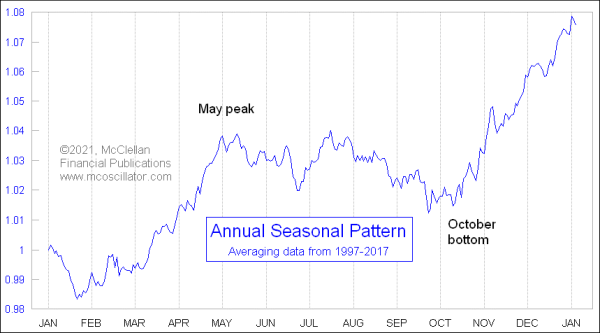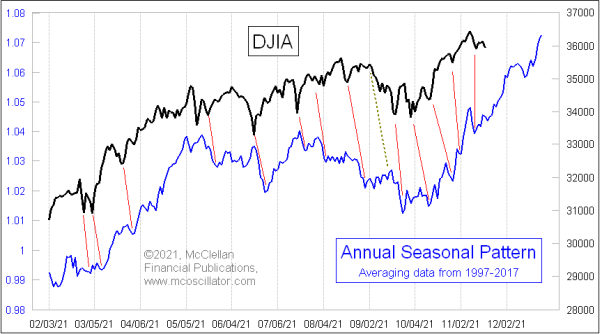Exploring the Mysteries of Seasonality

Free Chart In Focus email
Delivered to you every week
Stock market analysts have long known that there is an annual seasonal pattern affecting the behavior of stock prices, and the major indices. Theories and explanations for why that occurs have arisen over the years, and one longstanding one is that seasonality in the stock market relates to the farming harvest cycle. Grain farmers harvest in the autumn, and sell their product, and that sends ripples through the banking system as money gets moved around to purchase the grain and pay the farmers. That is one sensible explanation for why stock prices should be affected. But there are others.
I like to say that when it comes to the overall stock market, there are only two fundamentals that matter: (1) How much money is there? and (2) How much does that money want to be invested? The farming/banking hypothesis applies to factor #1, but human emotions can be a strong factor governing #2.
It turns out that human emotions get affected a lot by annual seasonality, as both the number of hours of daylight and the ambient temperature we all experience affect our moods. These effects tend to be magnified the further north one lives, as the day length closer to the Arctic Circle varies a whole lot more than at the equator.
In 2013, researchers from Finland and Sweden examined regional suicide data from those countries since 1750, in a paper published here. What they found was that suicides had two peaks per year, at times that match important inflection points in the Annual Seasonal Pattern. Here is a quotation from the paper’s abstract:
Suicide rates in Finland and Sweden peak twice a year. Both men and women in both countries most often commit suicide in May. There is another peak in October, with the exception of Finnish men. These suicide peaks coincide with a temperature increase in May and the biggest annual drop in temperature in October. We also observed a monotonic long-term change in the Swedish statistics, but not in the Finnish data. Our hypothesis is that seasonal variation in suicide rates may be caused by abrupt temperature changes twice a year that trigger the activity in brown adipose tissue and deepen depression.
The fascinating part of this is that the Scandinavian suicide rate peak in May occurs at the same time as a top for stock prices. The second peak in suicides in October coincides with a price bottom. Both of these suicide rate peaks mark extremes of emotion, and inflection points for stock prices, but in an opposite fashion in terms of price direction. This is the key point to understand about seasonality, that it is not about how money moves around the banking system, but rather about how emotions move around within the brains of investors. Climactic points of emotion result in greater suicide rates, and in greater inflection in the price action.
Seasonality in this current year (2021) displays an interesting twist. The stock market is following the average behavior of past years really closely, but with the turns arriving about a week or so early.

The turns in the DJIA have matched those in its Annual Seasonal Pattern, but they have been arriving several days early this year. I do not have a good explanation for this behavior. But it is consistent behavior so far this year, so there must be some underlying cause, shifting the effects of seasonal fluctuations in investor moods to a few days earlier than normal. If a market behavior is consistent enough, even though we may not have an explanation for it, we can eventually start to believe in it. The latest minor low seemed to be more on time, so maybe the market is getting back on the schedule correctly now. Or maybe it is just an anomaly.
I do not bring up the topic OF suicide lightly. It is the ultimate expression of human mood swings, and it has multiple causes and factors. I have lost 2 friends to suicide, both coincidentally after suffering significant head injuries. Individuals going through an emotional crisis experience multiple emotional inputs, and seasonality is only one factor.
There are resources to help, and anyone experiencing suicidal thoughts should know that you are not alone, and help is available. Episodes of suicidal thoughts tend to pass, and things get better. That is what we see in the greatest measure of emotion, the movements of the stock market.
If you know of someone expressing suicidal thoughts, please take it seriously, and don’t be afraid to talk to them about it. Talking about it does not amplify a person’s willingness to go through with it, but more often it mitigates those feelings and recognizes what they are going through. Encourage them to call the National Suicide Prevention Lifeline at (800) 273-TALK, or your local county crisis hotline. Let them know that such feelings are cyclical in their nature, going back centuries, and thus something that can pass and yield to better days.
Tom McClellan
Editor, The McClellan Market Report
Sep 02, 2021
Seasonal Turns Arriving Early |
Jun 10, 2021
Seasonality Versus The Fed |
Aug 09, 2018
How Seasonality Has Changed |